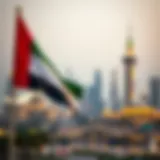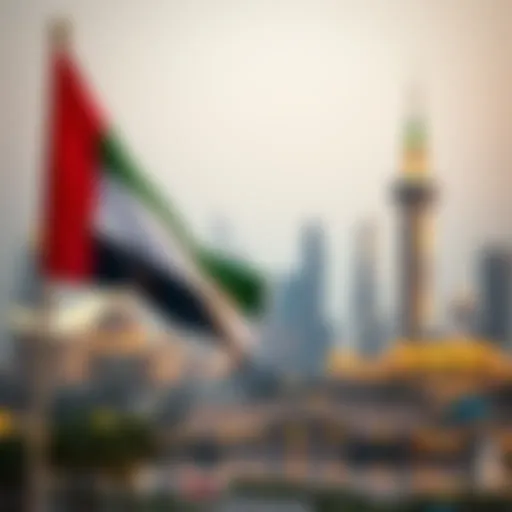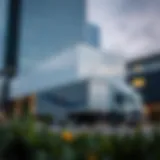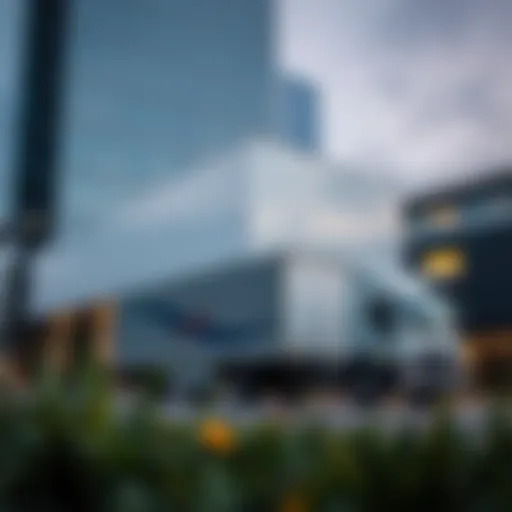Navigating Dubai's Metro and Tram Systems: A Complete Guide


Intro
Dubai’s sprawling urban landscape is not just about towering skyscrapers and shimmering beaches; it’s also an intricate web of transportation options, central to the city’s rhythm. Navigating the metro and tram systems offers both practical benefits and an insight into the metropolitan pulse. These systems have evolved to accommodate the booming population, significantly reducing reliance on personal vehicles while seamlessly connecting key areas of interest. This article will guide you through the specifics of Dubai's metro and tram systems, emphasizing their importance in opening up real estate opportunities and improving urban connectivity.
Property Market Overview
Current Market Trends
The property market in Dubai appears to be on an upward trajectory, with various sectors experiencing an uptick. This resurgence can be partly attributed to the efficiency of the transport systems in enhancing accessibility. Areas around metro stations are often more desirable, creating a surge in demand for properties close to these hubs. Investors are keenly observing how these transport routes impact property values; if you snooze, you might miss out on significant gains.
Key Neighborhood Insights
Several neighborhoods stand out when it comes to property investments near metro and tram lines:
- Dubai Marina: This upscale district has seen rising interest, largely due to its proximity to the metro. The vibrant lifestyle, coupled with easy access to public transport, makes it an attractive spot.
- Jumeirah Lakes Towers (JLT): With newly added tram stations, JLT’s appeal continues to grow. It's not just about affordability; it’s also about convenience.
- Downtown Dubai: Home to iconic landmarks, property prices here are booming. The metro's accessibility adds to its allure, attracting both buyers and renters.
Investing in these neighborhoods often means capitalizing on the benefits that come from public transport access, whether it be for personal use or rental yields. Let's delve deeper into how buyers and sellers can navigate this market effectively.
Buying and Selling Guidelines
Essential Steps for Buyers
When you're ready to dip your toes into the property market around the metro and tram systems, here are a few steps to consider:
- Research: Understanding the market trends is crucial. Websites like properties.ae provide valuable insights.
- Engage with Agents: Local agents can offer a wealth of information about the neighborhoods and current market conditions.
- Visit: Always take the time to walk around the area; what’s nearby can make or break a deal.
- Finance Options: Ensure you understand your financing options, whether it’s a mortgage or cash purchase. Clarity here can save you from headaches later.
Tips for Sellers
Selling in this fast-paced market has its own nuances. Here are some tailored tips for sellers:
- Highlight Proximity to Transport: Make sure your listing emphasizes how close it is to metro and tram stations. This can catch the eye of many potential buyers.
- Staging Matters: Consider staging your property to appeal to a wider demographic. A well-presented home goes a long way.
- Market Wisely: Utilize digital platforms effectively. Listings on sites like dubizzle.com can widen your reach.
"A good location near public transport may add significant value to your property, often more than renovations or upgrades."
Being aware of these tips can streamline the buying or selling process, positioning you favorably in the competitive market.
Operating within the confines of the metro and tram networks is more than a mere journey from point A to B; it's a strategic maneuver in the real estate game. By understanding the dynamics at play, you arm yourself with knowledge that can significantly influence your decisions in this thrilling market. Explore the intricacies of transport systems and watch how they interlace with Dubai’s ever-evolving property landscape.
Prolusion to Dubai's Transportation Landscape
Dubai's transportation landscape is a complex and evolving framework essential for enhancing the livability and accessibility of this dynamic city. With a population that has burgeoned thanks to rapid urbanization, the need for efficient and effective public transport solutions can’t be overstated. The metro and tram systems are not merely supplementary; they represent the backbone of urban mobility in Dubai, underpinning both daily commutes and overall economic activity.
Overview of Urban Mobility
Urban mobility in Dubai goes beyond the basics of getting from point A to point B. It encompasses the entire experience of navigating a sprawling metropolis where infrastructure meets innovation. The introduction of high-speed metro lines and an extensive tram network showcases a commitment to reducing traffic congestion and lowering carbon footprints. These systems enable residents and tourists alike to traverse the city with relative ease. Moreover, the well-planned routes align with the urban layout, connecting business districts, residential areas, and key landmarks.
The integration of public transportation options minimizes dependence on private vehicles, which can be a game-changer in a city known for its ambitious growth. Real-time apps guide thousands of users daily, making travel not just efficient but also intuitive. Commuters can feel assured, knowing that their transportation choices are as diverse as the city itself. Every train that rolls in sync with the next adds a layer of connectivity that enhances Dubai’s appeal.
Importance of Public Transport
Public transport holds significant importance in sustaining the socio-economic fabric of Dubai. Economically, it makes the city more attractive for investors, buyers, and developers. Properly functioning public transport systems can lead to an increase in property values and encourage development around transit stations. Potential buyers see areas near metro and tram stations as viable investments due to the reduced commute times they promise.
Moreover, from an environmental perspective, these systems contribute to lower greenhouse gas emissions by promoting shared modes of transport rather than the use of individual cars. With initiatives aimed at enhancing sustainability, Dubai aims to position itself as a leader in environmentally friendly urban planning. Investors in real estate would do well to understand this aspect, as it influences long-term value trends significantly.
In essence, navigating through Dubai’s transportation landscape means engaging with more than just physical pathways; it speaks to a strategic movement towards cohesive urban development, economic growth, and environmental stewardship. The direct impact of the metro and tram systems on daily life cannot be overlooked, as they symbolize progress, connectivity, and a vision for a smarter city.
The Dubai Metro: An Essential Component
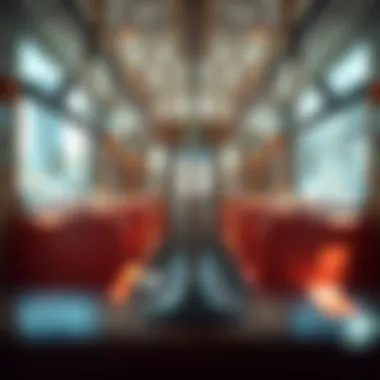
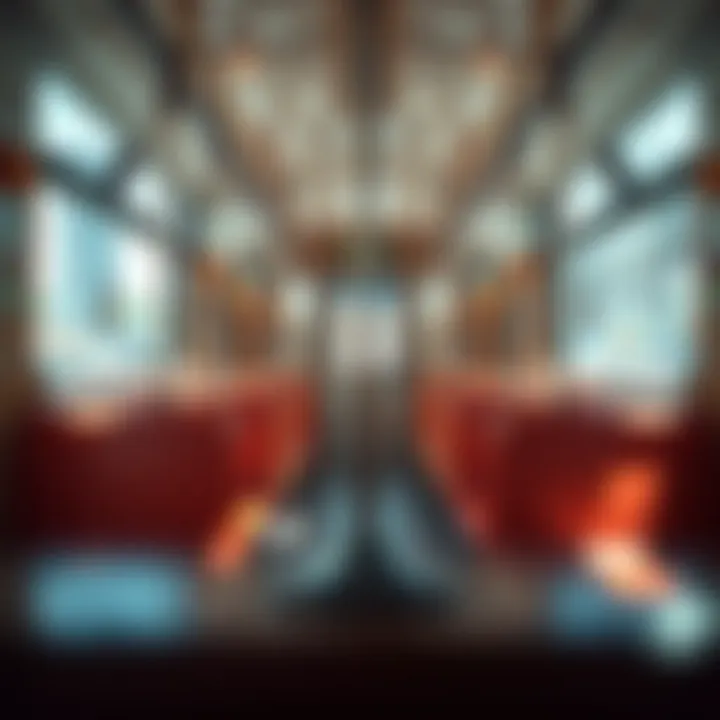
Dubai's Metro system stands as a cornerstone of the city's urban mobility framework. The significance of the Metro extends beyond mere transportation; it embodies a vision for a modern, connected, and sustainable metropolitan environment. Riders from all walks of life—business professionals, tourists, students—benefit from this integral network that helps alleviate the increasing traffic congestion and offers a reliable alternative to driving in Dubai's often bustling streets.
History and Development
The inception of the Dubai Metro can be traced back to the early 2000s, a time when the city began experiencing rapid urban growth. The first line, the Red Line, was inaugurated in 2009, marking a pivotal moment in Dubai's transportation history. Constructed in less than five years, the Metro was designed to support the bustling Expo 2020, reflecting the UAE's commitment to innovation and public transport advancements.
Since its launch, the Metro has undergone considerable expansions. The Green Line opened later in 2011, enhancing connectivity between the bustling neighborhoods of Bur Dubai and Deira. This development has paved the way for the forthcoming extensions, ensuring that the infrastructure aligns with the city's ever-evolving needs.
Metro Lines and Stations
The Dubai Metro comprises two main lines, the Red Line and Green Line, totaling around 90 kilometers of tracks, with more expansions planned to enhance connectivity even further. The Red Line primarily runs from Rashidiya to UAE Exchange, connecting critical areas such as Dubai International Airport and the Burj Khalifa.
- Key Stations:
- Burj Khalifa/Dubai Mall Station: A hot spot for tourists
- Dubai Marina Station: Servicing one of the city's most vibrant hotspots
- Union Station: A central hub connecting both lines
The Green Line serves vital residential areas and connects to key business districts, creating a much-needed link for daily commuters. Stations are equipped with modern amenities, ensuring travelers can seamlessly board and disembark while maximizing their convenience.
Operational Hours and Schedules
When planning your journey, knowing the operational hours is essential. The Metro typically runs from 5:00 AM to midnight on weekdays, with extended hours on weekends to accommodate late-night travelers. This schedule reflects an understanding of the local lifestyle and ensures that the Metro serves both early risers and night owls alike.
- Weekday Schedule:
- Sunday to Thursday: 5:00 AM - 12:00 AM
- Friday: 10:00 AM - 12:00 AM
- Saturday: 5:00 AM - 12:00 AM
Keeping these timings in mind, passengers can effectively plan their trips, whether it’s to catch an early morning flight or to enjoy an evening out in the city.
The Dubai Metro is not just a transport solution; it's a catalyst for social and economic growth, connecting communities and enhancing accessibility.
In summary, understanding the history, layout, and operation of the Metro is vital for navigating Dubai's dynamic urban landscape. As the city continues to grow, the Metro will play an increasingly pivotal role in shaping the future of urban mobility.
The Tram Network: Enhancing Connectivity
Tram System Overview
Dubai's tram network plays a crucial part in shaping the city's public transport landscape. Integrating seamlessly with its other transport systems, the tram service not only connects various communities but also brings a striking level of convenience to commuters and travelers alike. Opened in late 2014, the tram network covers a substantial stretch of land across the bustling Dubai Marina and Jumeirah Beach Residence (JBR).
The network consists of a single line with several stations, allowing travelers easy access to residential, commercial, and entertainment hubs. What sets this tram system apart is its design; it’s both modern and user-friendly, reflecting Dubai's commitment to maintaining a cutting-edge transport infrastructure. Furthermore, the utilization of light rail technology minimizes congestion on the roads, contributing to a smoother urban flow.
Stations and Route Information
The tram system features multiple strategically located stations. Each station is designed to cater to high foot traffic areas, ensuring that users can hop on and off without hassle. Key stations include the Dubai Marina, JBR, and Al Sufouh. This setup not only promotes mobility but also allows for easy transition between different modes of transport, including the metro and buses.
- Dubai Marina: Often viewed as the bustling heart of the tram network, this station is close to various restaurants, cafes, and the scenic marina.
- JBR: Serving residents and tourists heading toward the beach and shopping spots, this stop provides quick access to leisure activities.
- Al Sufouh: Nestled near key residential areas, it particularly benefits families and individuals living nearby.
The tram runs at intervals of approximately 10 to 15 minutes during peak hours, making it a reliable option for daily commuting. Connecting directly to the Metro's Red Line further enhances the routing, allowing for more efficient travel across the city.
Integration with the Metro
The integration of the tram network with the Dubai Metro is a prime example of a well-planned transport ecosystem. With multiple interchange stations, riders can easily transition from the tram to the metro, minimizing wait times and maximizing convenience. This synergy significantly benefits commuters, providing an effective alternative to car travel and promoting the use of public transport.
"Public transport, such as trams and metros, is not just about movement; it's about connecting communities."
Through smart ticketing options and cohesive scheduling, passengers experience a seamless journey from one end of the city to another. The reliance on smart technologies ensures that train arrival times are communicated clearly, reducing uncertainty and enhancing rider satisfaction.
Rider Experience: What to Expect
Understanding the rider experience in Dubai's metro and tram system is pivotal for both new and seasoned commuters. This section sheds light on essential aspects that enhance the overall journey, from how to manage ticketing to ensuring personal safety. A seamless experience aboard public transport can greatly influence daily life and even impact property investments near transit stations.
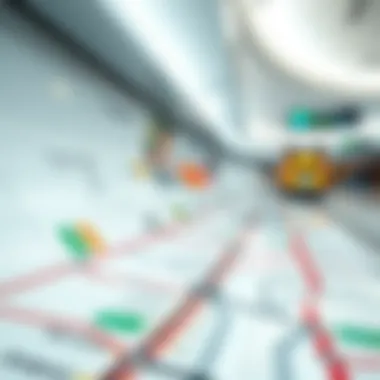
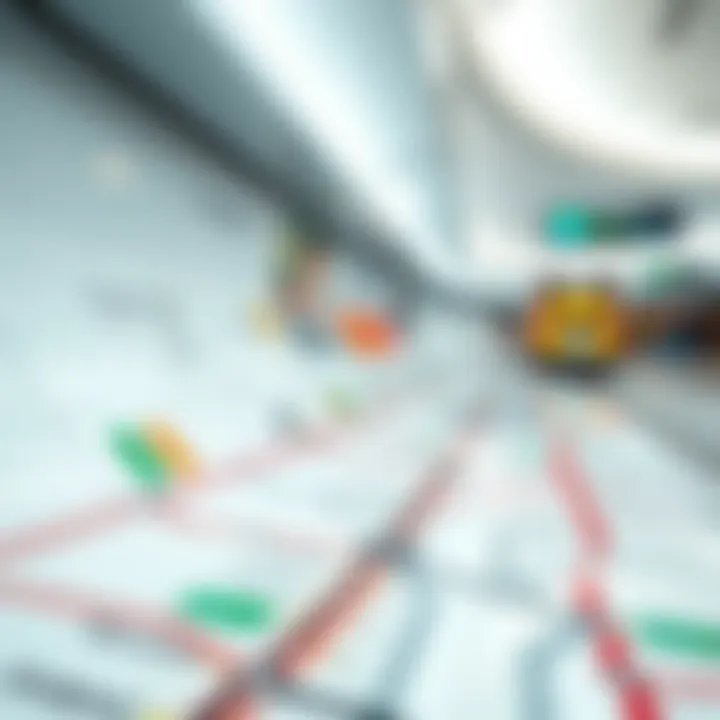
Ticketing and Fare Structure
Dubai's fare system is as straightforward as it gets. The primary means to travel across the metro and tram network is through a smart Nol card, which can be preloaded with credit. With options for a single journey, a monthly pass, or pay-as-you-go, riders may find flexibility that suits their needs.
- Nol Card Types:
- Red Ticket: Ideal for short-term users, perfect for a handful of trips.
- Silver Card: Designed for regular users, allows for cheaper travel per journey.
- Gold Card: Provides a touch of luxury with access to the Gold Class cabins, if available.
The fares differ based on zones crossed, which means budgeting for your trip is relatively easy. The price might start as low as four dirhams and can go up, depending on the distance. This clarity in ticketing not only streamlines the boarding process but also fosters greater trust in the system.
"The key to navigating the system lies in understanding how the fare structure operates."
Amenities on Board
When utilizing the metro and tram, expect an array of amenities that cater to comfort and convenience. Without a doubt, the well-thought-out design ensures riders enjoy a positive environment.
- Carriages: The trains and trams are air-conditioned, which can be a blessing during the warmer months. Comfortable seating arrangements and designated areas for women and children signal an effort to make public transport inclusive.
- Digital Displays: Real-time updates on next stops and timings keep everyone informed. It takes the guesswork from riders who are unfamiliar with the route.
- Wi-Fi Availability: Riders can take advantage of free Wi-Fi while they travel, making it easier to stay connected.
- Connectivity: Facilitated connections to other forms of transport, like buses or taxis, enhance the overall usability, proving that urban mobility is at the heart of Dubai’s public transport design.
Safety and Security Measures
In a bustling city like Dubai, safety and security cannot be overlooked. The metro and tram system boasts various measures that ensure peace of mind for all riders.
- CCTV Surveillance: The systems integrated within the transport vehicles operate round-the-clock ensuring constant monitoring. This not only deter possible criminal activities but also enhances the overall sense of security.
- Emergency Protocols: Well-placed emergency buttons and clear signage guide riders on what to do in various situations. Having a trained team of staff members on duty reassures riders that assistance is close at hand.
- Security Personnel: On-site staff, including both security and customer service representatives, can often be seen patrolling. Their presence alone contributes significantly to the safety ambiance.
- Cleanliness Standards: The metro and tram stations undergo regular sanitization, ensuring health and safety remains a priority, a particularly relevant factor in today’s climate.
Impact on Dubai’s Real Estate Market
The relationship between public transport systems and real estate values is a crucial topic, particularly in rapidly evolving cities like Dubai. Public transit can be a strong influence on property values and demand, changing the landscape of urban living. As Dubai’s metro and tram systems expand, they don't just facilitate commuting; they also reshape the real estate market. Buyers, investors, and developers must understand how these changes can affect both opportunity and valuation.
Influence on Property Values
The presence of a metro or tram station significantly alters the dynamics of nearby properties. When public transport options improve, property values can soar. As near as the metro stations, property buyers often prioritize proximity due to reduced commuting times. For instance, consider a one-bedroom apartment in Dubai Marina. Where its price may have been X amount before the tram line extension, its value can spike as new lines open, making it a viable option for those who prioritize accessibility.
This is evidenced by other urban areas globally; generally, homes within walking distance to public transport tend to appreciate quicker than those further away. In Dubai's context, despite the lavishness of nearby locales, the practical benefits of location near a transit station can sometimes outweigh ostentatiousness.
New Developments Near Transit Stations
Real estate developers in Dubai are increasingly looking toward areas surrounding metro and tram stations for new projects. The strategy is nearly foolproof; when a station is announced, it's followed by a surge of interest in residential and commercial properties. Dubai Hills Estate, for example, saw an uptick in development projects designed with the commuter in mind. Amenities that cater to ease of access become focal points. Shops, parks, and schools may crop up along newly established transit routes, further enhancing desirability.
The connection between transportation and urban planning yields a resurgence in neighborhoods once considered underdeveloped. The government actively encourages such endeavors by offering incentives. It’s not just about houses; it’s about creating communities that are vibrant, accessible, and integrated into the transit framework.
Trends in Investor Interest
Currently, many investors are pivoting their focus toward properties located near these public transport routes. The buzz among investors is palpable when discussing future developments. The trend has shifted from merely looking into luxury real estate into understanding how accessibility impacts desirability. Investors recognize that properties nearer to transit lines can not only maintain their value but appreciate over time, particularly in a growing metropolis like Dubai.
Some areas are predicted to become golden goose zones as these structures increase. People are drawn not just to live in these locales but to rent them out, creating hot spots for returns on investment.
Ultimately, public transport represents more than just a means of getting from point A to B – it’s a fundamental element that shapes the very fabric of urban real estate landscapes.
"Investing in proximity to transit isn’t merely about convenience — it’s about realizing the true potential of urban living in a city built for the future."
With rising investor interest, it's essential for stakeholders to keep their fingers on the pulse of city developments. In a rapidly transforming cityscape, playing your cards right with the knowledge of public transit paths could be the difference between a golden investment and a missed opportunity.
For additional reading, one may visit urban.org or check real-time discussions and statistics on platforms such as reddit.com.
Future Developments in Public Transport
The future of public transport in Dubai holds immense potential, which entwines itself with the aspirations of the city to become a global leader in urban mobility. As the population continues to expand and the urban landscape evolves, improving and innovating public transport systems is crucial. Understanding future developments is more than just knowing new lines or stops; it’s about grasping how these changes will benefit residents, tourists, and investors alike. The integration of advanced technology, alongside strategic expansions, creates a promising narrative around convenience and accessibility, factors that are highly valued by anyone engaging with Dubai's real estate market.
Upcoming Metro Expansion Plans
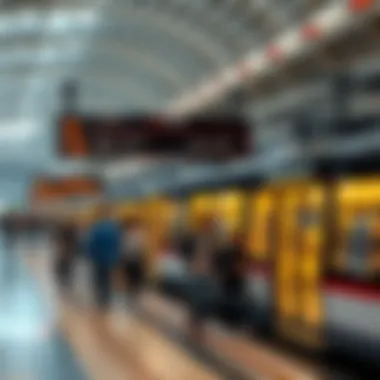
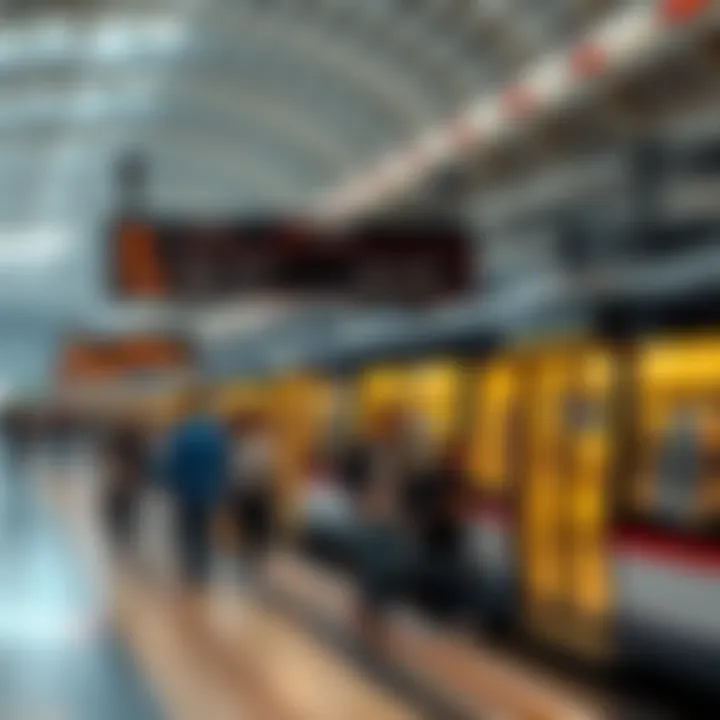
Dubai's metro system is set to expand significantly in the coming years. The expansion isn't merely about increasing the number of trains, but it’s also about enhancing connectivity across various neighborhoods and commercial hubs. Current plans envision extending existing lines as well as adding new routes. For instance, the Red Line extension aims to reach areas like the Dubai World Central, which is near the Al Maktoum International Airport. This creates an easier path for travelers, making a mark on both tourism and business travel.
The Green Line is also seeing planned expansions, targeting key areas with dense populations and high foot traffic. The further integration of the metro with other transport modes, such as buses and trams, will ease the movement within the city, reducing congestion and offering alternatives to private vehicle use. These enhancements contribute to a more comprehensive transport network, vital for investors eyeing properties in burgeoning areas.
Tracks and Stations Under Consideration
A number of projects are currently in the pipeline, including studies on potential new tracks and stations to link neighborhoods that have limited access to public transportation. Potential stations being discussed include access points along major thoroughfares that currently lack links, thus creating opportunities for mixed-use developments in underutilized areas.
Establishing transit-oriented developments (TOD) near these proposed stations can fuel demand in the real estate market. Investors should keep an ear to the ground regarding these proposals, as selections of these stations could significantly enhance property values in surrounding districts. The success of earlier developments near existing metro stations speaks volumes about the lucrative prospects of future installations.
Technological Advancements
As much as physical expansions are crucial, technological innovations will play an equally critical role in the evolution of Dubai’s public transport. Emerging technologies, like smart ticketing systems, real-time tracking apps, and contactless payments, will emerge to streamline user experience and make commuting more efficient.
Integrating Artificial Intelligence (AI) with transport logistics is another area of interest. This could range from optimizing schedules based on real-time demand to enhancing fleet management and maintenance operations. Such technologies promise not only to improve efficiency but also to enrich the rider experience by minimizing delays and maximizing convenience.
Furthermore, the utilization of sustainability-focused technologies—like solar-powered stations or electric vehicles—could be a game-changer, aligning public transport with the city’s ambitious sustainability targets. By championing green technologies, Dubai could set a perfect example for other cities while simultaneously attracting environmentally conscious investors.
In a city as innovative as Dubai, the alignment of transport, technology, and community priorities does not merely represent future trends but also reflects core principles of smart urban planning and sustainability.
Practical Tips for Navigating the System
Navigating a new public transport system can often feel like swimming in uncharted waters. In Dubai, with its vast and intricate metro and tram network, having some practical tips can make the journey smoother and more enjoyable. Understanding these tips not only eases day-to-day commuting but also enhances the overall rider experience. This section provides useful insights for both seasoned and new travelers, ensuring that everyone can efficiently traverse the city’s public transit landscape.
Planning Your Journey
Before setting off on your adventure through Dubai’s transit networks, it's crucial to have a solid plan in place. Knowing your starting point and destination is just the initial step. Here’s what to consider:
- Understand the Metro and Tram Maps: Familiarize yourself with the layout of both the metro and tram systems. Key stations like Union, where the Red and Green metro lines intersect, serve as critical transfer points. The tram system, primarily in Dubai Marina, also connects well with the metro, making it essential to know routes.
- Station Names: Pay attention to the station names, which can sometimes be a mouthful—like this one: Jumeirah Lakes Towers. Take time to practice saying them to avoid confusion.
- Plan for Delays: Whether due to maintenance or events, service disruptions can occur. It’s wise to allow extra time for unexpected delays, so being punctual won't become a battle of nerves.
- Travel During Off-Peak Times: If possible, avoid peak hours to sidestep the bustling crowds. Early mornings and late afternoons, especially on weekdays, can feel like a sardine can, especially on the metro.
Taking these steps can save a headache, ensuring smooth travels across the city.
Useful Apps and Resources
In this digital age, mobile applications and online resources are indispensable tools for public transport navigation. Here are apps that can streamline your journey:
- RTA Dubai: This official app from the Roads and Transport Authority offers real-time information about metro and tram schedules, routes, and available services. Its user-friendly interface makes planning your trip a breeze.
- Google Maps: A familiar name, this app can provide step-by-step directions and estimated travel times. It also accounts for real-time traffic conditions and public transportation options, helping you choose the fastest route.
- Dubai Metro Guide: This app focuses solely on the metro system, offering details about all stations, ticket prices, and service alerts. Handy for those who mostly use the metro.
- Local Forums and Social Media: Platforms like Reddit often have groups where locals share their experiences, tips, and tricks about navigating the system. Engaging with communities can provide insights not found in regular guides.
Utilizing these resources equips travelers with the information needed to navigate efficiently.
Common Challenges and Solutions
Every system has its bumps in the road, and public transport is no different. Here are some frequent challenges riders may face, and how to tackle them:
- Language Barriers: While many signs are in English and Arabic, there may still be occasions where language becomes a hurdle. Using translation apps can help, or just learning a few key phrases can make a big difference.
- Crowded Cars: During peak hours, trains and trams can become crowded, which can lead to anxiety or discomfort, especially for newcomers. Try to find a corner spot for some personal space or stand near the doors for easier access when your station arrives.
- Misplaced Fare Cards: Losing your Nol Card can lead to a hassle. Keep your card in a designated pocket or strap it to your bag to ensure it doesn’t get lost in the shuffle.
- Understanding Ticket Types: With different ticket options based on the journey type and duration, confusion can arise. Research the fare system on the RTA website or app before your trip so you can choose the best option accordingly.
Tackling these challenges head-on not only refines the travel experience but also promotes a sense of confidence while navigating the system.
Closure
The conclusion serves as the cherry on top of the whole cake, tying everything together and illuminating the importance of navigating Dubai's metro and tram systems. In this bustling metropolis, where urban mobility is crucial, understanding the intricacies of public transport not only benefits riders but also influences stakeholders across various sectors. The way the metro and tram systems are structured influences a host of factors from accessibility to real estate value. By comprehensively grasping these elements, investors, buyers, agents, and developers can position themselves advantageously in the rapidly changing landscape of Dubai.
Summary of Key Insights
As we wrap up, let’s take a moment to revisit the main points discussed:
- Public Transport’s Role: The metro and tram systems are more than just a means of getting from point A to B. They are essential to enhancing connectivity across the city, making them pivotal in urban planning.
- Economic Implications: From raising property values in proximity to transit stations to attracting investors looking at the potential growth of real estate projects, the impact is substantial.
- User Experience Matters: The integration of user-friendly fare structures, amenities on board, and safety measures augments the overall experience, encouraging more residents and tourists to explore the city using these services.
- Future Developments: Ongoing expansions and the introduction of technology in public transport promise to make rides even more efficient and seamless in the coming years.
Implications for Stakeholders
Stakeholders across various sectors have a vested interest in the success and growth of Dubai's public transport systems. For investors, understanding the nuances of how these transport networks function can illuminate opportunities for profitable real estate ventures. Developers can leverage insights on planned expansions to forecast market demands and trends effectively.
- Real Estate Agents: Having knowledge of areas with new tram or metro stations can guide agents in advising clients looking to buy properties that could appreciate in value.
- Private Investors: As infrastructure improves, potential returns on investments in proximity to those transport lines can be significant.
- Urban Planners and Authorities: Efficient public transport planning ensures better resource allocation and addresses the ever-growing needs of the urban landscape.
To sum it all up, navigating the metro and tram systems in Dubai is not just about convenience; it's a strategic decision influenced by a myriad of factors that resonate beyond mere transportation. For all stakeholders involved, keeping a finger on the pulse of this evolution can yield fruitful opportunities.




